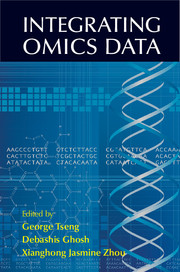Book contents
- Frontmatter
- Contents
- Contributors
- Introduction
- Part A Horizontal Meta-Analysis
- 1 Meta-Analysis of Genome-Wide Association Studies: A Practical Guide
- 2 MetaOmics: Transcriptomic Meta-Analysis Methods for Biomarker Detection, Pathway Analysis and Other Exploratory Purposes
- 3 Integrative Analysis of Many Biological Networks to Study Gene Regulation
- 4 Network Integration of Genetically Regulated Gene Expression to Study Complex Diseases
- 5 Integrative Analysis of Multiple ChIP-X Data Sets Using Correlation Motifs
- Part B Vertical Integrative Analysis (General Methods)
- Part C Vertical Integrative Analysis (Methods Specialized to Particular Data Types)
- Index
- Color plates
5 - Integrative Analysis of Multiple ChIP-X Data Sets Using Correlation Motifs
from Part A - Horizontal Meta-Analysis
Published online by Cambridge University Press: 05 September 2015
- Frontmatter
- Contents
- Contributors
- Introduction
- Part A Horizontal Meta-Analysis
- 1 Meta-Analysis of Genome-Wide Association Studies: A Practical Guide
- 2 MetaOmics: Transcriptomic Meta-Analysis Methods for Biomarker Detection, Pathway Analysis and Other Exploratory Purposes
- 3 Integrative Analysis of Many Biological Networks to Study Gene Regulation
- 4 Network Integration of Genetically Regulated Gene Expression to Study Complex Diseases
- 5 Integrative Analysis of Multiple ChIP-X Data Sets Using Correlation Motifs
- Part B Vertical Integrative Analysis (General Methods)
- Part C Vertical Integrative Analysis (Methods Specialized to Particular Data Types)
- Index
- Color plates
Summary
Abstract
Genome-wide chromatin immunoprecipitation experiments including ChIP-seq and ChIP-chip, jointly referred to as ChIP-X, are high-throughput technologies to map protein-DNA interactions in the genome. When multiple related ChIP-X data sets are available, separately analyzing each data set is not optimal because it may lack power to detect consistent but relatively weak signals in multiple studies. Jointly analyzing all data sets may allow one to borrow information across studies to improve signal detection. However, a common problem in data integration is the difficulty in handling data set–specific signals that cannot be dealt with by simply assuming that the signal status for each genomic locus is the same across all studies. An integration model that naively enumerates all possible study specificity patterns, conversely, has exponential complexity because there are 2D possible combinatorial signal presence and absence patterns for D studies. Correlation motifs provide a useful solution to this problem. By introducing a small number of latent probability vectors called correlation motifs, this approach can describe the major correlation structure among multiple data sets, which can then be used to guide information sharing across data sets. The correlation motif approach is capable of improving signal detection. At the same time, it does not have the problem of exponential model complexity and is flexible enough to handle all possible data set–specific signal configurations.
Introduction
Chromatin immunoprecipitation (ChIP) coupled with high-throughput sequencing (ChIP-seq) (Johnson et al., 2007; Barski et al., 2007) and ChIP coupled with genome tiling array hybridization (ChIP-chip) (Ren et al., 2000; Cawley et al., 2004) are two high-throughput technologies capable of mapping protein-DNA interactions (PDIs) genome-wide. These two technologies, collectively referred to as “ChIP-X,” have been widely used to produce information on transcription factor binding sites (TFBSs) (Johnson et al., 2007; Robertson et al., 2007), histone modifications (HMs) (Barski et al., 2007; Mikkelsen et al., 2007), nucleosome positioning (Schmid and Bucher, 2007), allele-specific PDIs (Mikkelsen et al., 2007; Rozowsky et al., 2011), variations of PDIs among the population (McDaniell et al., 2010; Kasowski et al., 2010), and the evolution of gene regulation (Schmidt et al., 2010). Today, ChIP-X has become an indispensable tool used by both individual investigators and large consortium projects such as the Encyclopedia of DNA Elements (ENCODE), modENCODE, and Roadmap Epigenomics consortia to annotate the human genome and epigenome (Consortium, 2012; Celniker et al., 2009; Bernstein et al., 2010).
- Type
- Chapter
- Information
- Integrating Omics Data , pp. 110 - 132Publisher: Cambridge University PressPrint publication year: 2015

